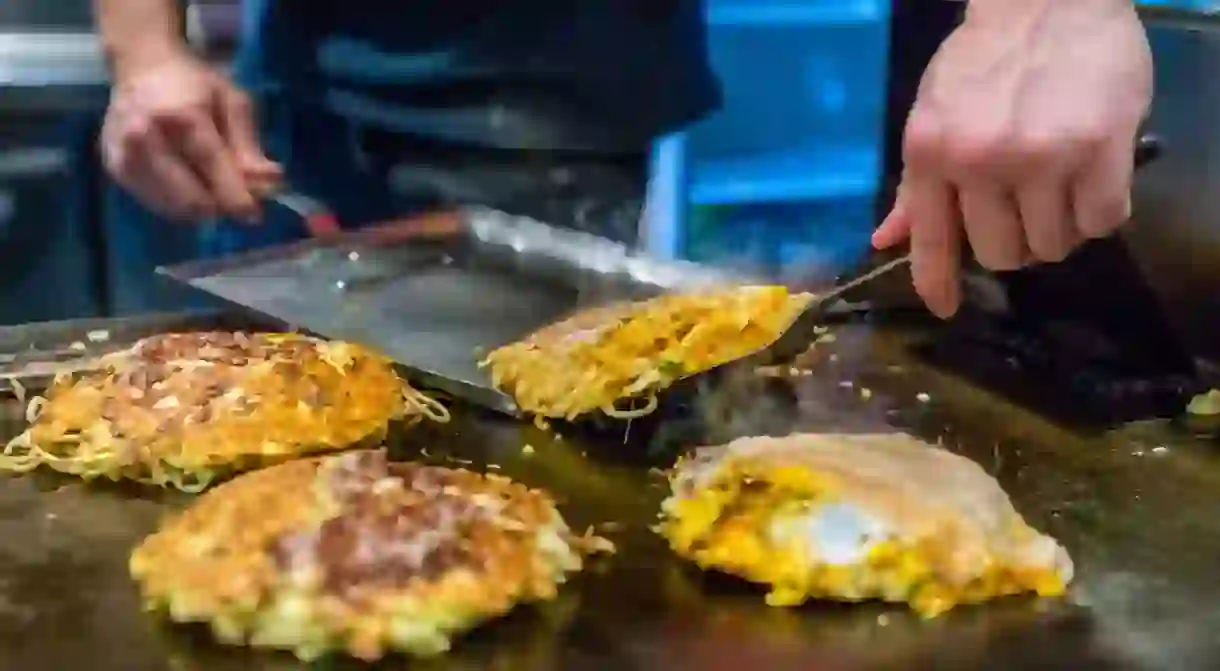Famous Osakan Dishes and Where To Eat Them

In a country where culinary perfection is the norm, Osaka has managed to earn the reputation of being ‘Japan’s kitchen’ – and there are a handful of dishes that prove its gustatory prowess. Here’s a guide to Osaka’s most iconic dishes and the best places to eat them.
Osaka can be summed up with one word: kuidaore. It means ‘to ruin yourself through extravagance in food’. It is this spirit which has made Osaka the food capital of Japan, and a powerful contender for one of the best culinary cities in the world. Even when it stands up against formidable opponents like Tokyo – the city with the highest number of Michelin-star restaurants on Earth – the attitude of Kuidaore makes Osakans unique in their single-minded pursuit of gustatory dominance. Here’s a guide on how to go from riches to delicious ruin in eight iconic Osakan dishes.
Snack on takoyaki at Aizuya
Snack Bar, Japanese
Feast on okonomiyaki at Mizuno
Restaurant, Japanese
Translated literally, okonomiyaki means ‘whatever you want, grilled’. The dish was popularised during the Second World War, when food was scarce and people cobbled together whatever they had to make something hot and filling. The hodge-podge spirit of okonomiyaki has naturally given way to several different versions. In Osaka, this dish is a pancake with cabbage, slices of meat and whatever else you want piled on top and drizzled with various sauces, and perhaps the best place to try it is Mizuno, a restaurant which traces its roots to post-WWII Japan. Here they use yam instead of flour, which makes the texture of the dough extra soft and imparts a natural sweetness which pairs well with pork and vegetables.
Dip and devour skewers of kushikatsu in Daruma
Restaurant, Japanese
Slurp on a bowl of shoyu ramen at JinseiJET
Restaurant, Japanese
In 1945, Americans took advantage of a rice shortage by flooding the market with cheap wheat flour. It was towards the end of WWII when the production of ramen – and its popularity – surged. Since its desperate origins, ramen has become one of those rare foods that caters to both to broke college students and the most serious foodies. And luckily for both, there’s no shortage of places to enjoy a bowlful in Osaka. For a restaurant that isn’t overcrowded with tourists, head to JinseiJET in Fukushima. People queue out the door for a bowlful of their shoyu (soy sauce-based) bowls. The broth is the right amount of oily and peppery; the noodles hit the sweet spot between springy and chewy; and the pork topping is mouthwateringly fatty and tender.
Grill yakiniku at Ogawatei Torachan
Restaurant, Japanese
In a street filled with famous yakiniku (grilled meats) restaurants, Ogawatei Torachan stands out with its nondescript shop front and decor – unlike the others in the area, it does not draw attention to itself. The focus here is on the quality of the meat. The owner sources beef from small-scale farms based in Yamagata, known for velvety soft, marbled cuts which melt in the mouth, and uses only the best sun-dried salt available in Japan. Find this peaceful restaurant set back from the crowded strip just off Tsuruhashi station.
Try kitsune udon at Dotonbori Imai Honten
Restaurant, Japanese
The ‘udon vs soba’ debate runs deep in Japan. Tokyoites tend to prefer soba but in Osaka, udon shops reign supreme. And of all the variants of this thick wheat flour noodle, it’s kitsune udon that most frequently graces the menu. Kitsune udon is made with a hot dashi stock and topped with deep-fried tofu. This dish is famous all over Japan, but actually originated in Osaka. Try it at Dotonbori Imai Honten, a traditional restaurant that has served the beloved soul food since 1946.
Chow down on butaman at 551 Horai
Snack Bar, Japanese
551 Horai is a national chain, but it’s ubiquitous in Osaka. Headquartered in the city’s Namba district, it’s among the best – and definitely most popular – places to find tasty pork buns, or butaman as they’re known locally (most other Japanese say nikuman). Though some branches of 551 (pronounced ‘five five one’, or go go ichi in Japanese) offer seating options, many are humble street stalls or pop-ups in busy train stations. Most shops allow you to view the chefs behind the glass, kneading and baking the buns nonstop for the never-ending queues – the breakneck speed is captivating.
Experiment with horumon at Sora
Restaurant, Japanese
Siukei Cheung contributed additional reporting to this article.













